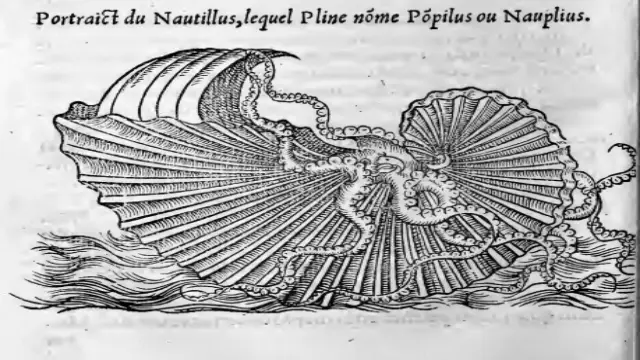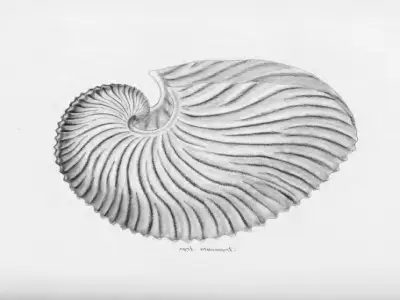For centuries, the Paper Nautilus (Argonauta argo) has fascinated humans. Ancient scholars like Aristotle described it as a “sailor of the sea,” using its delicate shell to navigate the waves. But how much of this description was fact, and how much was fiction? Let’s explore the myth, science, and enduring allure of this remarkable creature.
What Did Aristotle Say About the Paper Nautilus?
Aristotle, in his History of Animals, wrote about the Paper Nautilus with great detail. He claimed:
- The nautilus rises from the depths with its shell inverted.
- It uses a thin membrane between two tentacles as a sail.
- Two other tentacles act as rudders to steer.
- If alarmed, it fills its shell and sinks.
This poetic account inspired generations of writers, poets, and naturalists. From Pliny the Elder to Lord Byron, the image of the sailing nautilus captured imaginations worldwide.

The Poetic Legacy of the Sailing Nautilus
The myth of the sailing nautilus didn’t stop with Aristotle. Writers and poets romanticized the creature for centuries:
Pliny the Elder
In his Natural History, Pliny echoed Aristotle’s description, reinforcing the idea of the nautilus as a skilled sailor.
Oppian
In his poem Halieutics, Oppian wrote:
“Two feet they upward raise, and steady keep;
These are the masts and rigging of the ship:
A membrane stretched between supplies the sail.”
Lord Byron
Byron’s The Island called the nautilus:
“The sea-born sailor of his shell canoe,
The ocean Mab, the fairy of the sea.”
James Montgomery
Montgomery’s Pelican Island painted a vivid picture:
“Light as a flake of foam upon the wind,
Keel upward from the deep emerged a shell.”
Alexander Pope
Even Pope’s Essay on Man praised the nautilus:
“Learn of the little Nautilus to sail,
Spread the thin oar, and catch the driving gale.”
These works turned the nautilus into a symbol of freedom, exploration, and harmony with nature.
The Scientific Reality Behind the Myth
While the descriptions were poetic, modern science tells a different story. Let’s separate fact from fiction.

What Is the Paper Nautilus?
The Paper Nautilus (Argonauta argo) is a type of cephalopod related to octopi and cuttlefish. Unlike true nautiluses, it belongs to the subclass Coleoidea, not Nautiloidea.
The Shell’s True Purpose
Contrary to ancient beliefs, the shell isn’t a boat or a home—it’s an egg-case! Female Paper Nautiluses secrete this delicate structure to protect their eggs. While it does provide buoyancy, it lacks the air chambers found in true nautilus shells.
How Does the Paper Nautilus Move?
The nautilus doesn’t sail. Instead:
- It uses a siphon to propel itself through water, just like other octopi.
- Two of its eight tentacles hold onto the shell while swimming.
- When resting, it often drags the shell along the seabed.
Size and Rarity
Most Paper Nautilus shells are small, but some can grow quite large. A specimen with a diameter of over 10 inches sold for $500 in the 1850s! Even today, large shells fetch high prices among collectors.
Why Did the Myth Persist?
The myth of the sailing nautilus endured because it resonated deeply with human imagination. Here’s why:
- Symbolism: The nautilus represented freedom, adaptability, and harmony with nature—qualities people admired.
- Limited Observation: Ancient observers lacked modern tools to study marine life closely.
- Poetic License: Writers embellished Aristotle’s account, making it more fantastical over time.
Ancient Wisdom vs. Modern Science
The nautilus myth highlights a broader theme: the tension between ancient wisdom and modern science. For centuries, people relied on observations passed down through generations. However, empirical research revealed truths that challenged these beliefs.
Lessons Learned
- Question Assumptions: Just because something is widely accepted doesn’t make it true.
- Value Both Perspectives: Ancient accounts offer cultural insights, while science provides factual clarity.
- Stay Curious: Mysteries still exist in the natural world, waiting to be uncovered.
The Enduring Allure of the Paper Nautilus
Despite debunking the sailing myth, the Paper Nautilus remains captivating. Its delicate shell, unique reproductive strategy, and mysterious behavior continue to inspire awe. Whether viewed as a sailor of the seas or a marvel of evolution, it reminds us of the wonders hidden beneath the waves.
Conclusion
The story of the Paper Nautilus bridges ancient mythology and modern science. While Aristotle’s vision of a sailing cephalopod may have been flawed, it reflects humanity’s timeless fascination with the unknown. Today, we know more about this incredible creature, but its beauty and mystery endure.
So next time you see a shell washed ashore, take a moment to appreciate the secrets it holds—and the stories it has inspired.
Did you enjoy learning about the Paper Nautilus? Share your thoughts below! Have you ever encountered a marine myth that intrigued you? Let’s dive deeper into the ocean’s mysteries together!

